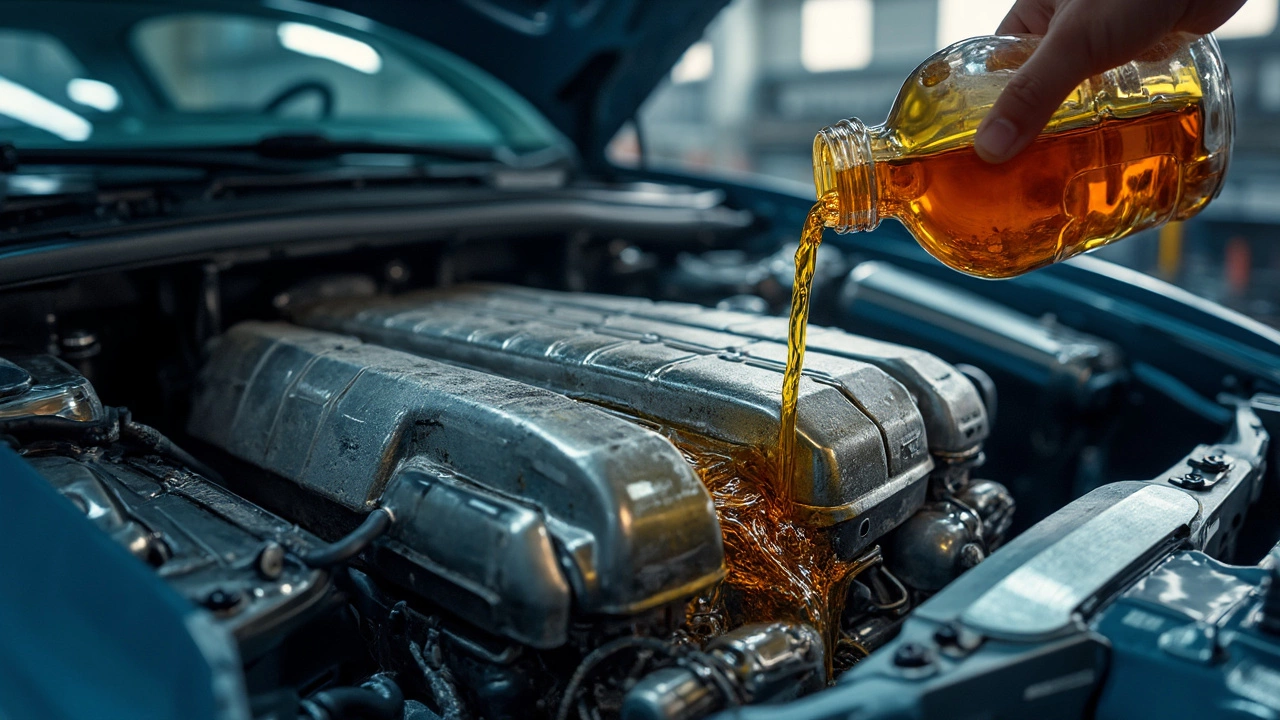If you've ever wondered why mechanics preach the gospel of regular oil changes, it's about more than just selling more service. Picture your engine as the very heart of your vehicle, pumping vital fluids to keep it alive. Oil plays the role of your car's lifeblood—lubricating, cooling, and cleaning all those moving parts. Forgetting to change it? That's like asking your engine to run a marathon with sludge instead of blood. Sound intense? That's because it is.
Oil doesn't last forever. Over time, it thickens and its additives start wearing out. This old, dirty oil can't do its job well, which means parts begin to rub together, heat up, and eventually wear down. You may not see the damage right away, but keep ignoring it, and your ride might just decide to stop playing nice—right in the middle of your morning commute.
So, what should you do? The easiest way to know if an oil change is due is by checking your car's manual or simply keeping an eye on your dashboard. Most cars make it pretty clear when your oil is low or too old. And if you're feeling DIY-friendly, changing oil isn't rocket science. With a bit of effort and careful attention to details, you can do it yourself and save some cash.
- Why Oil Changes are Essential
- Consequences of Ignoring Oil Changes
- How to Know When to Change Your Oil
- Tips for DIY Oil Changes
- Common Myths About Oil Changes
Why Oil Changes are Essential
Ever wonder why you can't just fill your car with engine oil and call it a day? Routine oil changes are like regular health check-ups for your vehicle, making sure things run smoothly. Here's why skipping them isn't a good idea.
Lubrication: Engine parts, like pistons and valves, move at super high speeds under the hood. Without proper lubrication from fresh oil, these parts would grind against each other, causing wear and tear faster than you can say "repair bill." New oil keeps everything slick and smooth.
Cooling: All those moving parts generate heat. Ever touched an oven when it's on? Yeah, it's like that. Oil helps to move some of this heat away, keeping your engine from becoming a fiery inferno.
Cleaning: As your oil circulates, it picks up dirt and grime—the kind you'd never want building up in your engine. Over time, oil gets dirty, it's like trying to clean a window with muddy water. Those oil changes swap out the contaminated stuff for fresh, efficient oil.
Oil Longevity: More Than Just Distance
You might think you're off the hook if you don't drive much. But oil also deteriorates over time, not just from driving. That's right, even your garage queen needs fresh oil every so often, usually every 6 months to a year, depending on your car's needs.
Engine Longevity: Seems obvious, but it's worth mentioning: neglecting this small task can drastically reduce your engine's lifespan. It's like sending your car to an early grave when it could live long and prosper.
- Check your owner's manual for the recommended oil change interval.
- Consider synthetic oil for longer-lasting protection, especially if you're often in extreme temperatures.
These essential small steps, called oil changes, not only keep your car running smoothly but also help avoid serious problems down the line.
Consequences of Ignoring Oil Changes
Skipping regular oil changes might seem like you're saving time or money, but this decision can actually lead your car into a world of trouble. First off, without fresh oil, your engine's parts start to suffer from a lack of lubrication. Moving parts grind against each other, generating more heat and causing more wear and tear. This friction not only impacts performance but also sets the stage for potential engine failure.
Alongside lubrication issues, dirty engine oil becomes thick and sludgy, clogging the oil filter. Think of it as trying to breathe through a straw that's been stuffed with cotton. The oil circulation slows down, leading to overheating and increased exhaustion of parts like pistons and cylinders. Long-term neglect can even result in complete breakdowns, leaving you stranded at the worst possible times.
Increased Engine Wear and Damage
To really put the importance into numbers, studies have shown that engines running on dirty oil can experience a significant reduction in their lifespan—often by as much as half. Imagine what this means for expensive components like your crankshaft or camshaft. These aren't small bills; we're talking potential expenses that could rival the cost of a family holiday.
Poor Fuel Efficiency
But that's not all—ignoring oil changes can hit you right in the wallet in terms of fuel economy, too. Dirty oil forces your engine to work harder, burning more fuel in the process. So while you think you're skimping on maintenance costs, you're actually spending more on petrol or diesel. Not exactly the savvy savings plan you might have been hoping for.
Environmental Impact
Lastly, there's the environmental side to consider. Worn-out oil produces more emissions, playing its part in the ongoing saga of pollution and air quality issues. Responsible care for your vehicle isn't just about economy—it's about doing your part to keep the planet in better shape, too.
In short, the consequences of skipping oil changes are far-reaching. So, next time you're tempted to delay for the sake of convenience, remember the big picture—engine longevity, performance, and the ever-important savings can all rest on something as simple as fresh oil.

How to Know When to Change Your Oil
Knowing when it's time to switch out your engine oil isn't rocket science. Most cars these days come equipped with built-in reminders, which make life a whole lot easier. Your car's manual usually has this vital info in black and white too. But let’s break it down so you can avoid any guesswork.
The Mileage Rule
For years, the rule of thumb was to swap out the oil every 3,000 miles. But with advancements in car maintenance and engine technology, many experts now suggest you can safely stretch that interval to somewhere between 5,000 to 7,500 miles and even up to 10,000 miles for specific synthetic oils. Check the manufacturer’s specs for the right number.
The Dashboard's Tattle-tale
Your car is smarter than you know. Some newer models have electronic oil monitors that alert you when oil quality dips. Treat it like your car's polite way of saying, "Hey, I could use a little refresh here." Heed the dashboard lights or indicators as soon as they pop on.
Listen to Your Engine
If your engine starts sounding more like a hungry bear in the winter than a purring kitten, it might be time for that oil change. Unusual noises can be a sign that your engine isn't happy, possibly due to thick or old oil.
Regular Checks
Pop open the hood and pull out the dipstick now and then. Fresh oil is amber and clear, whereas darker, thick oil signals time for a change. If you notice the oil levels dropping too frequently, it might mean your engine's burning oil, which could be a bigger issue.
Factors That Matter
Your driving habits and conditions can also affect how often you need an oil change. Frequent short trips or driving in extreme weather might wear out your oil faster. If you're in doubt, consult your manual or drop by a reliable mechanic.
Don't get caught out by ignoring these signs. By keeping a close eye on these indicators, you're doing your bit to extend your engine's longevity and save yourself from unexpected repairs.
Tips for DIY Oil Changes
Taking engine oil matters into your own hands can be straightforward and rewarding. No expert skills required, just some basic tools, a little time, and you’re all set. Let's dive into the nitty-gritty of how to pull off a successful DIY oil change.
Gather Your Tools and Supplies
You’ll need a few key items to get started. Here's your shopping list:
- A ratchet wrench and an oil filter wrench
- A new oil filter and the correct grade and amount of fresh oil (check your owner's manual for specifics)
- An oil catch pan to collect old oil
- A funnel for pouring new oil without spilling
- Some old newspapers or cardboard to protect your driveway
Step-by-Step Guide
- Warm Up Your Engine: Run your car for a few minutes. Warm oil flows out easier than cold oil.
- Secure the Vehicle: Park on a level surface, ensure the car is off, and secure with the parking brake. Safety first!
- Set Up: Lay down your cardboard or newspapers to catch any spills, and place the oil catch pan under the engine.
- Drain the Oil: Use the ratchet to loosen the drain plug carefully, and let the old oil completely drain into the pan.
- Replace the Oil Filter: Unscrew the old oil filter with the wrench and install the new one. Rub a bit of new oil on the rubber gasket of the new filter before installation to ensure a proper seal.
- Add New Oil: Use the funnel to pour in the new oil. Check the oil level with the dipstick and add more if necessary.
- Double-Check Everything: Ensure the oil cap is back on tightly, and check under the car for leaks.
Disposing the Old Oil
Don’t just throw out the old oil with the garbage—it's hazardous waste. Most local auto shops or recycling centers will accept used oil and old filters. Check with them for the designated drop-off point.
Nailing a DIY oil change isn't just about saving a few quid. It ensures your car is running at peak performance, upholding the promise of smooth rides and perhaps even preventing mid-drive hiccups.

Common Myths About Oil Changes
When it comes to oil change wisdom, there's loads of info floating around, but not all of it hits the mark. Let's clear up some of those common myths.
Myth 1: You Need an Oil Change Every 3,000 Miles
This is one of those classic pieces of advice that's been around forever, but these days it's not always true. Thanks to advances in engine oil technology and car manufacturing, many newer models aren't desperate for oil changes until 5,000 or even 7,500 miles have ticked by. Always check your car's manual or consult with a mechanic to get the right interval for your specific car.
Myth 2: If the Oil is Black, It Needs Changing
Oil gets dirty, that's just its job. Turning black isn't necessarily a red flag. As it cycles through your engine, it picks up impurities. What matters more is the oil's consistency and level. If it still feels slick and hasn't dropped below the recommended level, you might be good for a while.
Myth 3: Synthetic Oil Causes Leaks
Once upon a time, synthetic oil got a bad rap for causing leaks. Truth is, if an engine's gaskets are worn out, it's going to leak no matter what oil you use. High-quality synthetics can actually be better for your car maintenance, providing superior performance and protection.
Myth 4: You Can Mix Oil Types
This one's a bit tricky. In a pinch, mixing different types of oil (like synthetic and conventional) won't necessarily spell doom for your engine, but it's not ideal for engine longevity. Stick with what's recommended for your vehicle to keep things running smoothly.
- Changing oil yourself saves money, but make sure you dispose of the old oil responsibly.
- Most people overestimate how much oil a car actually needs, so always measure it out rather than guessing.
Next time someone passes on oil change advice like it's ancient wisdom, you can separate the myths from reality. A little information really goes a long way in keeping your car's engine happy and healthy.

